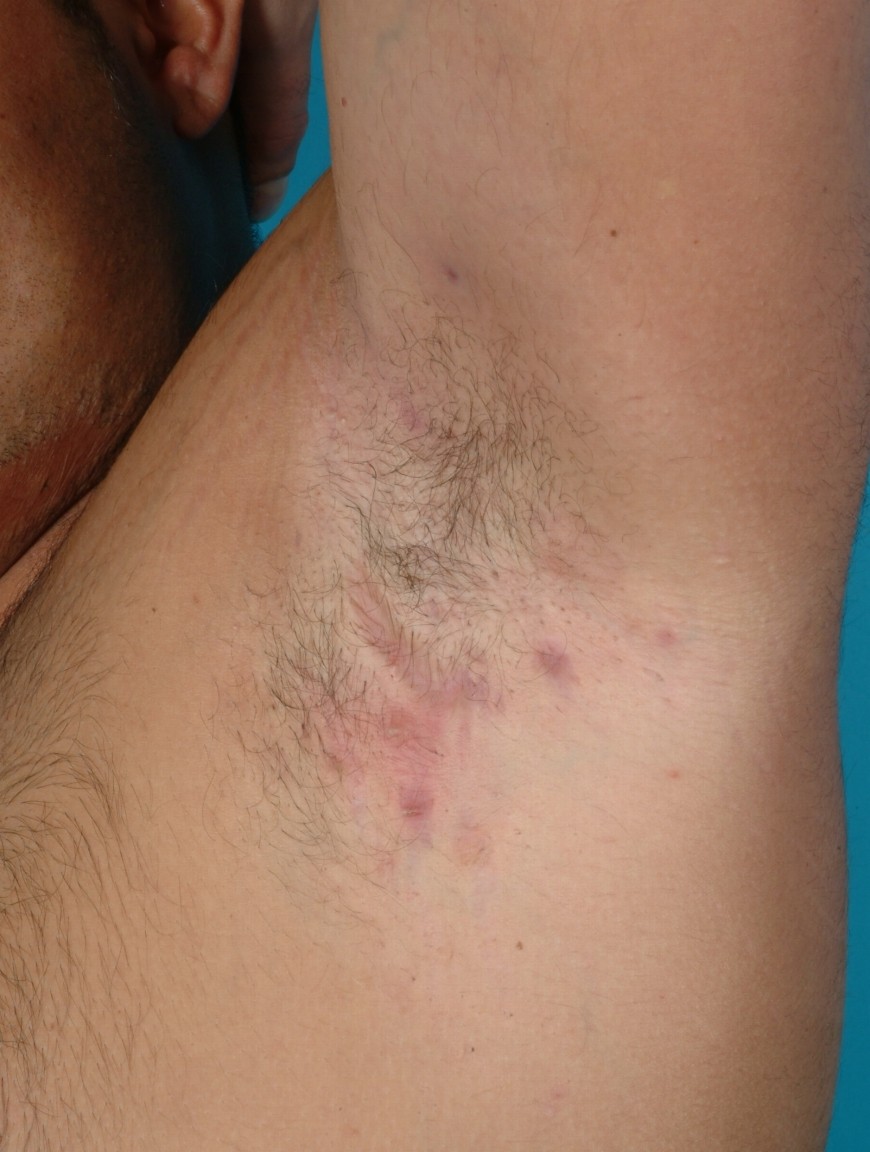Hidradenitis Suppurativa: Symptoms, Causes, Treatment
What are the symptoms of hidradenitis suppurativa?
Hidradenitis suppurativa (HS) is a chronic skin condition that causes painful, swollen lesions to form in the hair follicles and sweat glands, typically in areas where skin rubs together, such as the armpits, groin, buttocks, and under the breasts. Symptoms of HS can vary in severity and may include:
- Painful lumps or nodules: These are often the first sign of HS and can be pea-sized or larger. They may be firm, inflamed, and tender to the touch.
- Abscesses: These are collections of pus that form under the skin and can be very painful. They may rupture and drain fluid.
- Tunnels or tracts: Over time, the lumps and abscesses can connect under the skin, forming tunnels. These can be felt as firm, rope-like structures under the skin.
- Scarring: As the condition progresses, the skin may become scarred and thickened, especially in areas where lesions have healed.
- Pain and itching: The affected areas can be painful, especially when the lesions are inflamed or infected. Some people may also experience itching.
- Recurrent flare-ups: HS is a chronic condition, and symptoms may come and go over time. Flare-ups can be triggered by factors such as stress, hormonal changes, or friction from clothing.
- Secondary infections: The open wounds and drainage from abscesses can lead to secondary bacterial infections, which can cause additional symptoms such as fever, chills, and malaise.
HS can have a significant impact on quality of life due to the pain, discomfort, and embarrassment it can cause. It’s important for individuals with HS to seek medical treatment by healthcare providers to help manage symptoms and prevent complications.
What are the causes of hidradenitis suppurativa?
The exact cause of hidradenitis suppurativa (HS) is not well understood, but it is thought to involve a combination of factors, including:
- Blockage of hair follicles: HS is believed to begin with blockage of hair follicles, typically in areas where skin rubs together, such as the armpits, groin, buttocks, and under the breasts. This blockage may be due to factors such as dead skin cells, bacteria, or abnormal immune response.
- Inflammation: Once the hair follicles are blocked, inflammation occurs, leading to swelling, redness, and pain. The immune system may play a role in the inflammatory response seen in HS.
- Bacterial infection: The blocked hair follicles and inflamed tissue create an environment where bacteria can thrive. This can lead to the formation of abscesses and further inflammation.
- Hormonal factors: Hormones may play a role in the development of HS, as the condition often begins after puberty and is more common in women. Changes in hormone levels, such as those that occur during menstruation, pregnancy, or menopause, may trigger or worsen symptoms.
- Genetics: There appears to be a genetic component to HS, as the condition often runs in families. Certain genetic factors may predispose individuals to developing HS.
- Lifestyle factors: Factors such as obesity, smoking, and excessive sweating may also contribute to the development or worsening of HS.
It’s important to note that while these factors are believed to play a role in the development of HS, the exact cause of the condition is still not fully understood, and more research is needed to determine the underlying mechanisms.
What is the treatment for hidradenitis suppurativa?
The treatment for hidradenitis suppurativa (HS) depends on the severity of the condition and may include a combination of lifestyle changes, medications, and surgical procedures. Here are some common treatment options:
- Lifestyle changes: Avoiding tight clothing, maintaining a healthy weight, and practicing good hygiene can help reduce friction and sweating, which can worsen HS.
- Topical treatments: Mild cases of HS may be treated with topical medications, such as antibiotics or corticosteroids, to reduce inflammation and prevent infection.
- Oral antibiotics: For more moderate to severe cases, oral antibiotics may be prescribed to reduce inflammation and control bacterial infection. These are often used for short periods to avoid antibiotic resistance.
- Anti-inflammatory medications: Nonsteroidal anti-inflammatory drugs (NSAIDs) or corticosteroids may be prescribed to reduce inflammation and pain.
- Biologic therapies: In cases where other treatments have not been effective, biologic therapies, such as TNF-alpha inhibitors, may be used to reduce inflammation and control symptoms.
- Surgical procedures: In severe cases or when other treatments have not been effective, surgery may be recommended to remove affected tissue or drain abscesses. In some cases, surgical removal of the affected sweat glands may be necessary.
- Laser therapy: Laser treatment may be used to help reduce inflammation and scarring in some cases of HS.
- Pain management: Over-the-counter pain medications or prescription painkillers may be used to help manage pain associated with HS.
It’s important for individuals with HS to work closely with a healthcare provider to develop a treatment plan that addresses their specific symptoms and needs. Early diagnosis and treatment can help manage symptoms and prevent complications.




